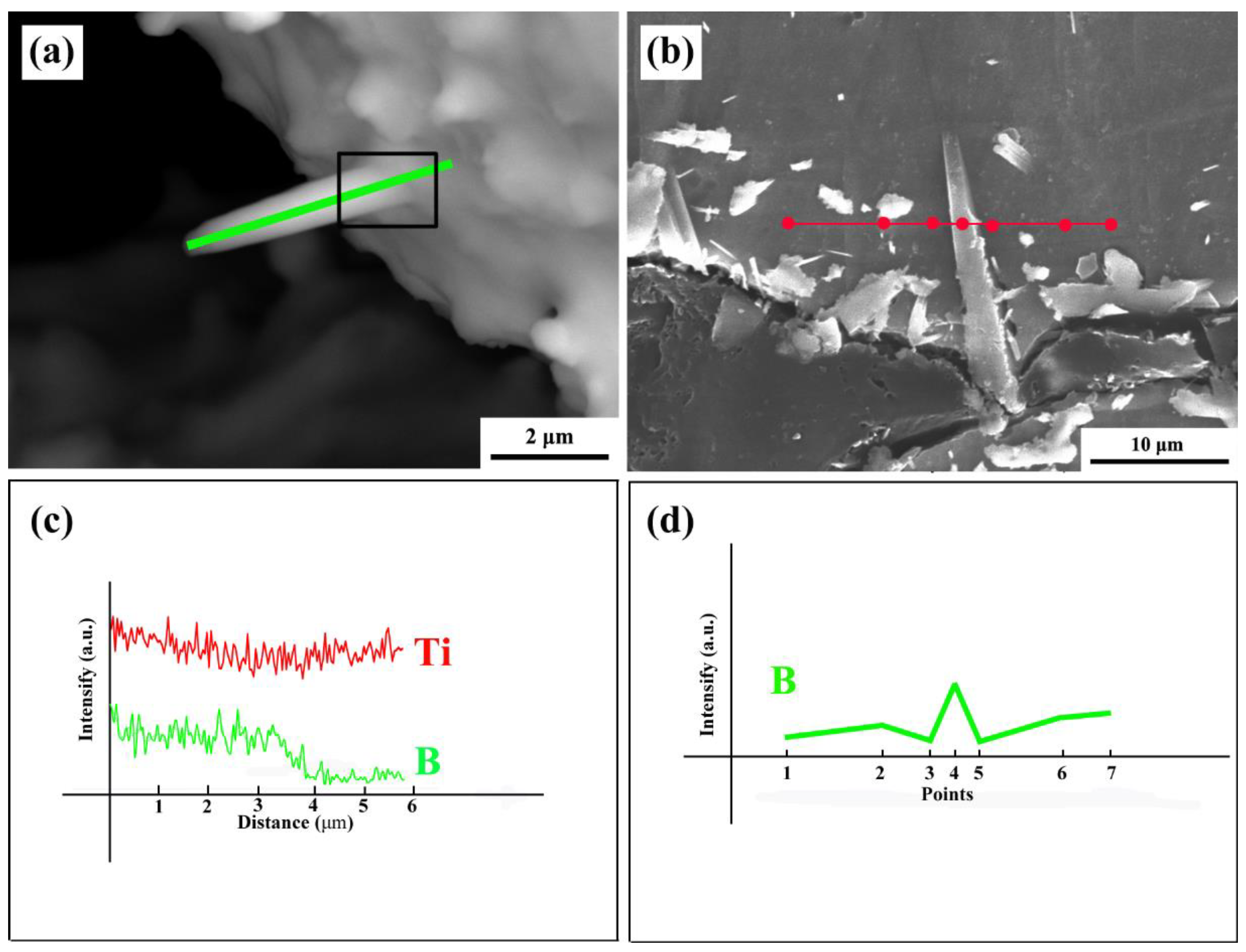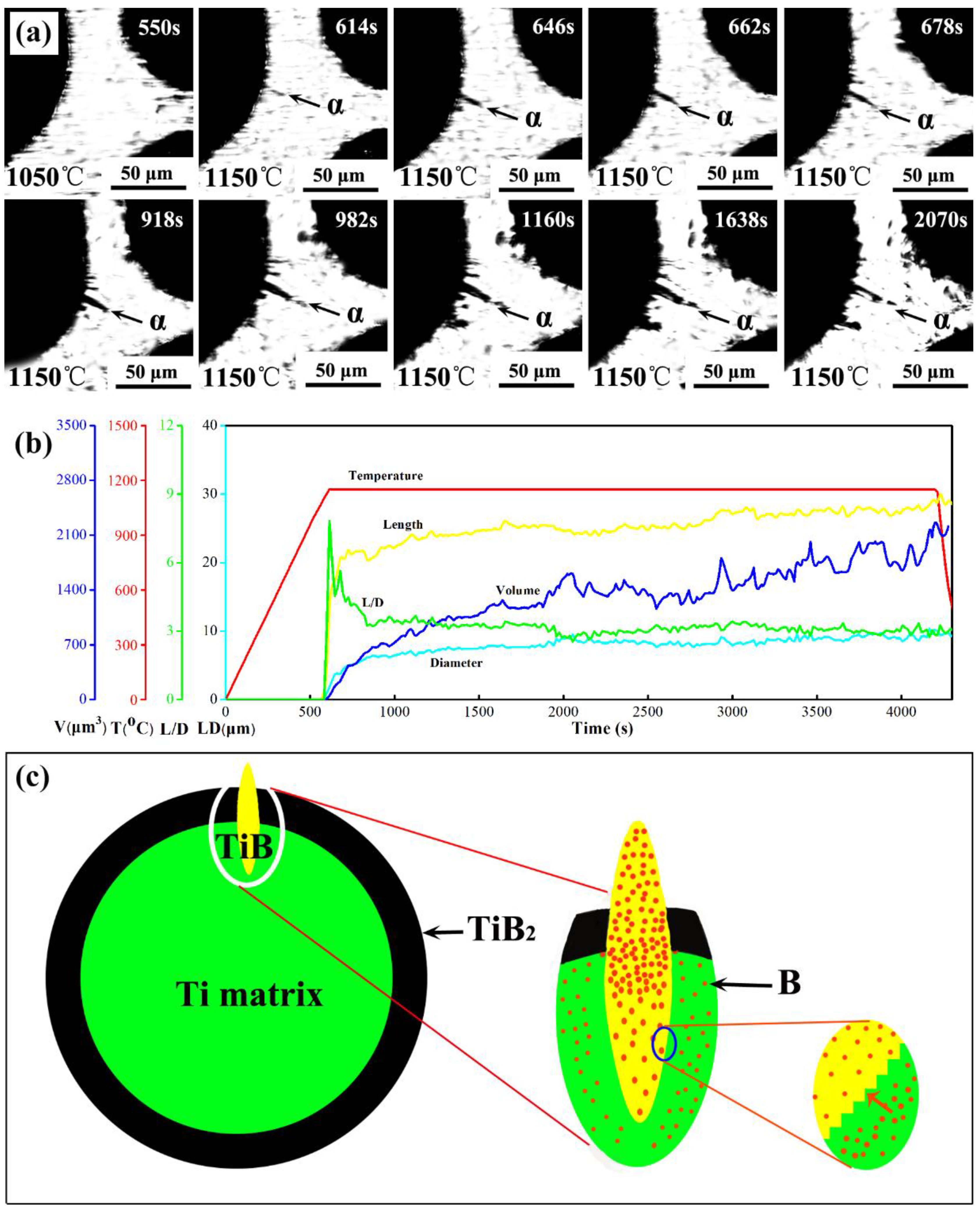The Sticking Out Mechanism and Growth of TiB Whiskers from TiBw/Ti-6Al-4V Composites during Sintering
Abstract
1. Introduction
2. Materials and Methods
3. Results and Discussion
4. Conclusions
Author Contributions
Funding
Conflicts of Interest
References
- Attar, H.; Nisch, M.B.; Calin, M.; Zhang, L.C.; Zhuravleva, K.; Funk, A.; Scudino, S.; Yang, C.; Eckert, J. Comparative study of microstructures and mechanical properties of in situ Ti–TiB composites produced by selective laser melting, powder metallurgy, and casting technologies. J. Mater. Res. 2014, 29, 1941–1950. [Google Scholar] [CrossRef]
- Hayat, M.D.; Singh, H.; He, Z.; Cao, P. Titanium metal matrix composites: An overview. Compos. A Appl. Sci. Manuf. 2019, 121, 418–438. [Google Scholar] [CrossRef]
- Morsi, K.; Patel, V.V. Processing and properties of titanium–titanium boride (TiBw) matrix composites—A review. J. Mater. Sci. 2007, 42, 2037–2047. [Google Scholar] [CrossRef]
- Tjong, S.C.; Mai, Y.W. Processing-structure-property aspects of particulate- and whisker-reinforced titanium matrix composites. Compos. Sci. Technol. 2008, 68, 583–601. [Google Scholar] [CrossRef]
- Zheng, Y.; Williams, R.E.; Wang, D.; Shi, R.; Nag, S.; Kami, P.; Sosa, J.M.; Banerjee, R.; Wang, Y.; Fraser, H.L. Role of ω phase in the formation of extremely refined intragranular α precipitates in metastable β-titanium alloys. Acta Mater. 2016, 103, 850–858. [Google Scholar] [CrossRef]
- Saito, T. A cost-effective P/M titanium matrix composite for automobile use. Adv. Perform. Mater. 1995, 2, 121–144. [Google Scholar] [CrossRef]
- Zadra, M.; Girardini, L. High-performance, low-cost titanium metal matrix composites. Mater. Sci. Eng. A 2014, 608, 155–163. [Google Scholar] [CrossRef]
- Feng, Y.; Cui, G.; Zhang, W.; Chen, W.; Yu, Y. High temperature tensile fracture characteristics of the oriented TiB whisker reinforced TA15 matrix composites fabricated by pre-sintering and canned extrusion. J. Alloy. Compd. 2018, 738, 164–172. [Google Scholar] [CrossRef]
- Chen, W.Z.; Yang, J.L.; Zhang, W.C.; Wang, M.M.; Du, D.D. Influence of TiBw volume fraction on microstructure and high-temperature properties of in situ TiBw/Ti6Al4V composites with TiBw columnar reinforced structure fabricated by pre-sintering and canned extrusion. Adv. Powder Technol. 2017, 28, 2346–2356. [Google Scholar] [CrossRef]
- Hou, J.B.; Gao, L.; Cui, G.R.; Chen, W.Z.; Zhang, W.C.; Tian, W.G. Grain Refinement of Ti-15Mo-3Al-2.7Nb-0.2Si Alloy with the Rotation of TiB Whiskers by Powder Metallurgy and Canned Hot Extrusion. Metals 2020, 10, 126. [Google Scholar] [CrossRef]
- Singh, H.; Hayat, M.; He, Z.; Peterson, V.K.; Das, R.; Cao, P. In situ neutron diffraction observations of Ti-TiB composites. Compos. Part A 2019, 124, 105501. [Google Scholar] [CrossRef]
- Tian, Y.S. Growth mechanism of the tubular Tib crystals in situ formed in the coatings laser-borided on Ti–6Al–4V alloy. Mater. Lett. 2010, 64, 2483–2486. [Google Scholar] [CrossRef]
- Hou, J.B.; Chi, F.H.; Cui, G.R.; Chen, W.Z.; Zhang, W.C. Strengthening effects of in-situ synthetic nano-TiC particles on Ti64 based nanocomposites through adding graphene nanoplatelets. Vacuum 2020, 177, 109431. [Google Scholar] [CrossRef]
- Attar, H.; Bönisch, M.; Calin, M.; Zhang, L.-C.; Scudino, S.; Eckert, J. Selective laser melting of in situ titanium–titanium boride composites: Processing, microstructure and mechanical properties. Acta Mater. 2014, 76, 13–22. [Google Scholar] [CrossRef]
- Ma, X.; Li, C.; Du, Z.; Zhang, W. Thermodynamic assessment of the Ti–B system. J. Alloy. Compd. 2004, 370, 149–158. [Google Scholar] [CrossRef]
- Wang, B.; Huang, L.J.; Liu, B.X.; Geng, L.; Hu, H.T. Effects of deformation conditions on the microstructure and substructure evolution of TiBw/Ti60 composite with network structure. Mater. Sci. Eng. A 2015, 627, 316–325. [Google Scholar] [CrossRef]
- Cherukuri, B.; Srinivasan, R.; Tamirisakandala, S.; Miracle, D.B. The influence of trace boron addition on grain growth kinetics of the beta phase in the beta titanium alloy Ti–15Mo–2.6Nb–3Al–0.2Si. Scr. Mater. 2009, 60, 496–499. [Google Scholar] [CrossRef]
- Fan, Z.; Guo, Z.X.; Cantor, B. The kinetics and mechanism of interfacial reaction in sigma fibre-reinforced Ti MMCs. Compos. A Appl. Sci. Manuf. 1997, 28, 131–140. [Google Scholar] [CrossRef]
- Chandran, K.S.R.; Panda, K.B.; Sahay, S.S. TiBw-reinforced Ti composites: Processing, properties, application prospects, and research needs. JOM 2004, 56, 42–48. [Google Scholar] [CrossRef]




Publisher’s Note: MDPI stays neutral with regard to jurisdictional claims in published maps and institutional affiliations. |
© 2020 by the authors. Licensee MDPI, Basel, Switzerland. This article is an open access article distributed under the terms and conditions of the Creative Commons Attribution (CC BY) license (http://creativecommons.org/licenses/by/4.0/).
Share and Cite
Cui, G.; Yang, B.; Hou, J.; Chen, W.; Zhang, W. The Sticking Out Mechanism and Growth of TiB Whiskers from TiBw/Ti-6Al-4V Composites during Sintering. Metals 2020, 10, 1467. https://doi.org/10.3390/met10111467
Cui G, Yang B, Hou J, Chen W, Zhang W. The Sticking Out Mechanism and Growth of TiB Whiskers from TiBw/Ti-6Al-4V Composites during Sintering. Metals. 2020; 10(11):1467. https://doi.org/10.3390/met10111467
Chicago/Turabian StyleCui, Guorong, Bo Yang, Jiabin Hou, Wenzhen Chen, and Wencong Zhang. 2020. "The Sticking Out Mechanism and Growth of TiB Whiskers from TiBw/Ti-6Al-4V Composites during Sintering" Metals 10, no. 11: 1467. https://doi.org/10.3390/met10111467
APA StyleCui, G., Yang, B., Hou, J., Chen, W., & Zhang, W. (2020). The Sticking Out Mechanism and Growth of TiB Whiskers from TiBw/Ti-6Al-4V Composites during Sintering. Metals, 10(11), 1467. https://doi.org/10.3390/met10111467



